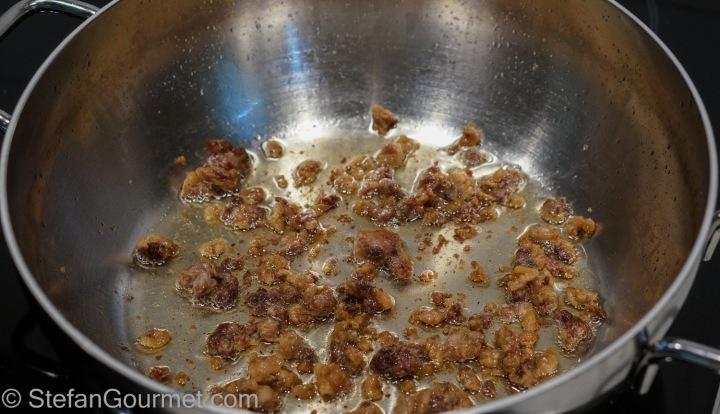
This pasta dish is inspired by Sapori Pugliesi, a humble trattoria in downtown Amsterdam. This place is in walking distance from where I work, and perfect for a quick, delicious and cheap meal after work if I’m going to stay downtown for whatever reason. They have great antipasti and fresh tagliatelle served with a variety of sauces. They also have delicious sandwiches for lunch. I really liked the “ragù allo chef”, which is a tomato sauce with slow-cooked beef, spiced with fennel seeds. My version is not the same, but what it does have in common is the use of fennel seeds. This makes the sauce different from a regular ragù napoletano.
It is important to use good stewing beef for this, with a lot of marbling (fat), and to cook it very slowly. A slowcooker (which I don’t own) would be perfect. I prefer to use semola di grano duro rimacinata (semolina flour) to make the tagliatelle, as that will give the pasta a coarse texture that will hold the sauce better. You could also use 00 flour if you can’t get semolina.
Ingredients
800 grams (1.8 lbs) stewing beef, cut into small cubes or strips
3 cans (400 grams/14 oz each) peeled tomatoes
1 Tbsp fennel seeds
4 Tbsp olive oil (or rendered beef fat)
salt and freshly ground black pepper
2 onions
2 garlic cloves
250 ml (1 cup) red wine
fresh tagliatelle made from 6 eggs and 600 grams of semola di grano duro rimacinata (or 800 grams (1.8 lbs) store-bought fresh tagliatelle)
freshly grated parmigiano reggiano, if desired
Preparation

The beef I used had a nice layer of fat, that I used instead of olive oil for additional flavor. I trimmed the fat from the beef, cut it into cubes, and put it in a casserole over medium heat.

After 10 minutes or so most of the fat had rendered, and I discarded the solids with the help of a slotted spoon. You could also use olive oil instead.

Brown the beef in batches over high heat in the rendered beef fat or the olive oil.

Once it’s browned on all sides, remove the meat with a skimmer and reserve. Repeat until you have browned all the meat.

Chop the onions and mince the garlic.

Once all the beef has been browned, add the onions and garlic to the same casserole. Add a bit of olive oil if needed. Sweat the onions until they are soft and fragrant over medium-low heat, about 10 minutes.

Add the fennel seeds and sauté for a minute longer.

Cook over medium-high heat until about half of the wine has evaporated.

Puree the tomatoes in the food processor. You could also use pureed tomatoes from a bottle, but the quality of the canned tomatoes I can get is better.

Add the tomatoes to the casserole, and stir to mix.

Add the reserved beef, and stir.

Bring to a boil, stirring. Season with salt and freshly ground black pepper.

Lower the heat and allow to simmer over the lowest possible heat, covered, until the beef is tender. The longer the better. I simmered it for 6 hours.

The heat should be so low that only once in a while a single bubble escapes. This way of simmering a sauce is called pippiare in Italian.

Stir the sauce now and then to prevent it from burning. Taste and adjust the seasoning with salt and freshly ground black pepper. Keep the sauce hot over low heat.

The classic way to cut fresh tagliatelle is to fold up the pasta and then cut ribbons of the desired width. Less than 1 cm (1/3 inch) is best for tagliatelle.

Cook the tagliatelle al dente in ample boiling salted water. This will only take a few minutes. Drain the tagliatelle, and add them to the ragù.

Toss until the tagliatelle is coated by the sauce.

Serve on warm plates, sprinkled with just a bit of freshly grated parmigiano if you like.
Wine pairing
As this dish is inspired by a chef from Puglia, a red wine from Puglia is a good choice for this. The grapes in such a wine have been slow-cooked by the sun, similar to the beef in this ragù. You will notice that the red wine will bring out the fennel seeds in the sauce. Using the same red wine for the sauce will also help to make a match ‘made in heaven’.
Flashback

These penne with roasted cauliflower, almonds and a cream sauce make for a filling pasta dish with great depth of flavor.




un eccellente piatto della tradizione culinaria italiana; meraviglioso
LikeLike
Stefan: this one I am going to copy to the letter. Yes, I am beginning to use fennel seeds a lot more often than I did also . . . but I am interested in the quantity of meat v that of the pasta here; you having cooked it in slightly bigger pieces than I normally do; the proportion of tomatoes to meat and, of course a cooking time way longer than I normally use for a ragu. Will be tried soonest!!!
LikeLike
This is very cruel! I only had an eggs sandwich for lunch and I’d kill for a bowl of pasta right now…
LikeLike
This really is a beautiful dish, Stefan.
LikeLike
What a great dish! Simply marvelous!
LikeLike
Grazie, Francesca.
LikeLike
Fantastic. Lovely food. I had to make a pasta to pair with some shop bought meatballs and tomato sauce. The pasta was the high point of a very disappointing dish. Needless to say, I did not buy the meatballs!
LikeLike
Yes, I do believe your recipe would be absolutely perfect for the slow cooker! Saving it for later!
LikeLike
Thanks for visiting and taking the time to leave a comment. Please let me know how it turns out for you.
LikeLike